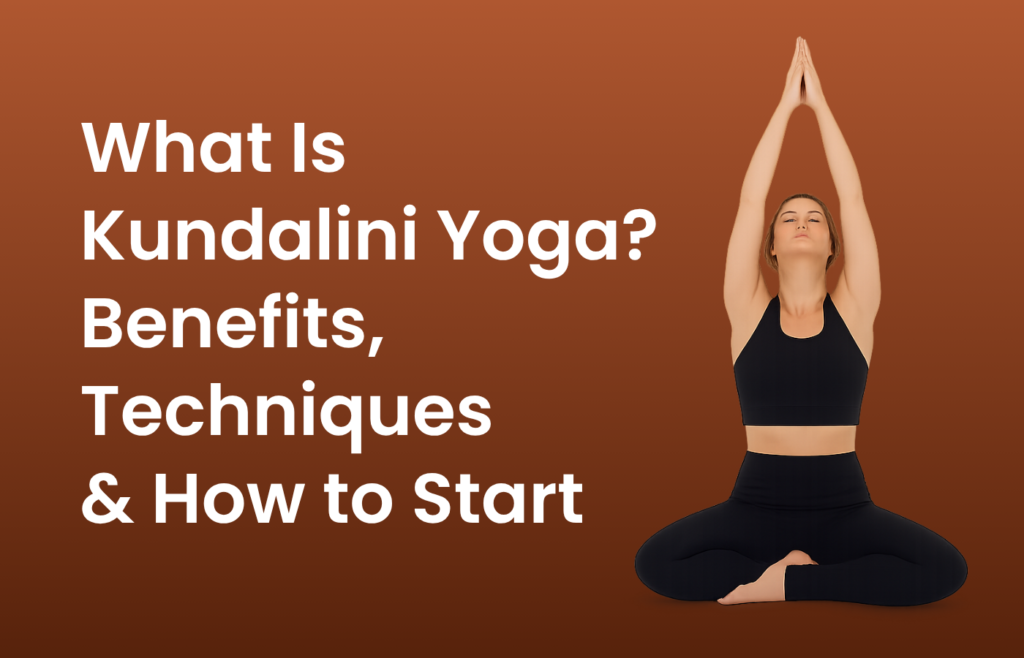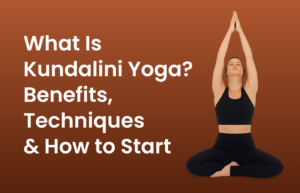
Have you ever felt like there’s untapped energy within you? Something powerful yet peaceful, waiting to be awakened? That’s exactly what Kundalini Yoga is about – awakening your inner energy to bring balance, clarity, and spiritual growth.
Unlike other types of yoga that mostly focus on the body, Kundalini Yoga works on your mind, spirit, and energy. It’s a deeply transformative practice that combines breathwork (pranayama), physical movements (kriyas), chanting (mantras), and meditation to awaken the dormant energy at the base of your spine known as Kundalini.
Let’s dive into what Kundalini Yoga is, explore its incredible benefits, learn about powerful techniques, and understand how beginners can start this journey confidently.
What Is Kundalini Yoga?
Kundalini Yoga is often referred to as the “Yoga of Awareness.” Its purpose is to awaken the Kundalini energy, a powerful spiritual energy coiled like a serpent at the base of your spine (in the Muladhara or root chakra).
This ancient practice combines various tools like:
-
- Breath control (Pranayama)
- Dynamic postures (Asanas and Kriyas)
- Mantras and chanting (like Sat Nam)
- Mudras (hand gestures)
- Meditation
When practiced regularly, these techniques stimulate the energy centers in your body (chakras), leading to heightened consciousness, inner peace, and emotional clarity.
While Kundalini Yoga has roots in ancient India, it was introduced to the West by Yogi Bhajan in the late 1960s. Today, it’s practiced globally from serene Himalayan villages to top yoga centres in Rishikesh, which quietly continue to offer authentic teachings of Kundalini Yoga for seekers worldwide.
Key Benefits of Kundalini Yoga
Kundalini Yoga is more than a physical exercise, it’s a complete system of transformation. Here are some of the most powerful benefits:
1. Energy Awakening & Mental Clarity
The primary goal is to awaken your dormant spiritual energy. Once this energy starts rising, people often experience enhanced intuition, mental clarity, and a sense of deep inner alignment.
2. Emotional Balance
Through breathwork and chanting, Kundalini Yoga helps release suppressed emotions and balances the nervous system. Practitioners report feeling lighter, calmer, and more emotionally stable.
3. Reduces Stress & Anxiety
Certain kriyas and breathing techniques reduce cortisol levels (stress hormones), helping you manage daily stress and anxiety naturally. This makes it especially beneficial for those with high-stress lifestyles or struggling with overthinking.
4. Boosts Creativity & Confidence
When your energy centers (chakras) align, your creative energy flows freely. Kundalini Yoga unlocks this flow, making you feel more inspired, expressive, and confident in your daily life.
5. Improves Focus and Brain Function
Regular practice sharpens your concentration and stimulates the pineal and pituitary glands, boosting your memory, awareness, and mental alertness.
6. Spiritual Growth
Kundalini Yoga connects you to a deeper sense of self. It’s not tied to any religion but invites self-awareness, gratitude, and purpose – essential tools for any spiritual journey.
Key Techniques Used in Kundalini Yoga
Kundalini Yoga uses a unique combination of techniques. You don’t need to master complex poses, the focus is on inner energy and consciousness.
1. Kriyas (Sets of Exercises)
Each kriya is a sequence of specific postures, breaths, and sounds designed to achieve a particular effect (e.g., detox the liver, awaken heart energy, or calm the mind). Some kriyas may last 3 minutes; others, 30.
2. Pranayama (Breathing Techniques)
Breathing is the heart of Kundalini Yoga. Popular techniques include:
-
- Breath of Fire: Rapid, rhythmic breathing through the nose that increases energy.
- Alternate Nostril Breathing: Balances both hemispheres of the brain.
- Long Deep Breathing: Relaxes the nervous system.
3. Mantras
Chanting sacred words raises your vibration. The most common mantra is “Sat Nam,” meaning “Truth is my identity.” It’s often repeated silently or aloud to anchor your awareness.
4. Mudras
These are hand gestures used during meditation or kriyas. They redirect energy within the body and support mental focus.
5. Meditation
Meditation is a core part of Kundalini Yoga, helping you tune into your inner self. Meditations often involve mantras, breath, and focused movement, sometimes lasting for 3–11 minutes.
How to Start Kundalini Yoga (Even If You’re a Beginner)
If you’re new, don’t worry. You don’t need to be flexible, fit, or spiritual to start Kundalini Yoga. You just need an open heart and a willingness to explore. Here’s how:
1. Learn from a Certified Teacher
Kundalini Yoga is a subtle yet powerful practice. Learning from a trained teacher ensures safety and proper guidance. While online options are available, nothing compares to the experience of learning at traditional yoga centres.
Many practitioners recommend learning from schools in India, especially in Rishikesh, where yoga is deeply rooted in tradition. Some of the top yoga centres here offer authentic Kundalini Yoga classes, combining ancient teachings with modern-day relevance.
2. Start with Short Sessions
Begin with 15–20 minutes daily. Focus on simple kriyas, breathing exercises, and mantras. You can increase the time gradually as your body and mind adjust.
3. Wear Comfortable Clothing
Loose, breathable white clothing is often recommended. Covering your head with a scarf or cotton cloth during practice is a common tradition in Kundalini Yoga, believed to protect your energy.
4. Practice in a Quiet Space
Choose a calm space where you won’t be disturbed. Sit on a yoga mat or wool blanket to support energy flow.
5. Be Consistent
Like any other yoga, the real magic happens with regular practice. Even just 11 minutes a day can bring noticeable shifts in your energy and mood.
Common Myths About Kundalini Yoga
Let’s address some common misconceptions:
-
- Myth 1: It’s religious.
Kundalini Yoga is spiritual, not religious. It’s open to all, regardless of beliefs.
- Myth 1: It’s religious.
-
- Myth 2: It’s dangerous.
If practiced under guidance, Kundalini Yoga is safe and transformative. Sudden energy surges may occur but are manageable with grounding techniques and rest.
- Myth 2: It’s dangerous.
-
- Myth 3: You need to chant loudly or dress a certain way.
These are optional. Your intention matters more than rituals.
- Myth 3: You need to chant loudly or dress a certain way.
Final Thoughts
Kundalini Yoga is a powerful tool to awaken your inner energy, build emotional resilience, and reconnect with your true self. It’s a journey of transformation, gentle yet deep.
For those who want to immerse themselves in a deeper experience, India remains a nurturing ground. Particularly, yoga hubs like Rishikesh offer immersive environments where Kundalini Yoga is taught in its purest form – through breath, movement, mantra, and silence.
Whether you’re seeking healing, clarity, or spiritual growth, Kundalini Yoga can be the bridge to a more conscious and fulfilling life. All you need is a willingness to show up, breathe, and let your energy rise.






